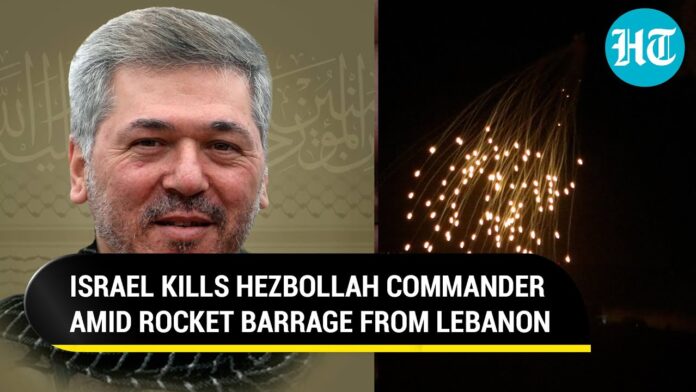Alleged Israeli airstrike claims the life of a senior Hezbollah commander, sparking retaliation with rocket attacks on Northern Israeli communities
In a series of escalating hostilities, a senior commander of Hezbollah was killed in an alleged Israeli airstrike in southern Lebanon. Hezbollah, the Iran-backed militant group, announced the death of Taleb Abdullah, a prominent figure within their ranks, stating that he was targeted “on the road to Jerusalem.” The strike, which occurred in the coastal town of Jouaiyya, resulted in the deaths of at least four other individuals, according to Lebanese reports. The Israeli Defense Forces (IDF) have not immediately commented on the strike.
The strike on Abdullah comes amidst heightened tensions between Israel and Hezbollah, as evidenced by the firing of over 80 rockets from Lebanon into northern Israeli communities throughout the day. The IDF responded with air defences intercepting some of the rockets, while others struck open areas. Dramatic footage captured the Iron Dome air defence system engaging a barrage of rockets over the city of Kiryat Shmona during Shavuot celebrations.
Additionally, the IDF conducted its own strikes on Hezbollah targets within Lebanon. A building used by Hezbollah, a rocket launching site, and other infrastructure were targeted in Aitaroun, while a Hezbollah rocket-launching cell was struck in Deir Aames by a drone. The escalating violence also saw the downing of a drone that crossed into Israel from Lebanon in the Upper Galilee region.
The day’s events follow recent IDF airstrikes on Hezbollah compounds in Lebanon, including a significant strike on a site belonging to Hezbollah’s Unit 4400 in the Baalbek region. This unit, responsible for logistical force build-up and weapon deliveries, is integral to Hezbollah’s operations. The airstrikes, according to Israeli sources, represent a response to ongoing provocations by Hezbollah and its allies.
Analysis:
Political: The exchange of airstrikes and rocket attacks underscores the ongoing tensions between Israel and Hezbollah, highlighting the volatile geopolitical landscape in the Middle East. The involvement of external actors, particularly Iran, adds complexity to the conflict and raises concerns about broader regional instability.
Social: The civilian casualties and disruptions caused by the rocket attacks underscore the humanitarian toll of the conflict, with civilians on both sides bearing the brunt of the violence. The situation exacerbates existing tensions and fears among residents in the affected areas, contributing to a sense of insecurity and instability.
Psychological Aspect: The continuous cycle of violence perpetuates a climate of fear and anxiety among the civilian populations living in the conflict zone. Fear of future attacks and uncertainty about the prospects for peace further compound psychological distress, impacting mental well-being and resilience.
Sociological Angle: The conflict between Israel and Hezbollah reflects deep-rooted historical grievances and geopolitical rivalries, with sectarian and ideological divides exacerbating tensions. The involvement of non-state actors and the proliferation of advanced weaponry pose challenges to traditional conflict resolution mechanisms.
Economic: The disruption of normal life and economic activities in the affected regions, coupled with the risk of escalation, has economic ramifications. Damage to infrastructure, loss of productivity, and increased security expenditures strain local economies and hinder prospects for sustainable development.
Environmental: The exchange of fire, including rocket attacks and airstrikes, poses environmental risks, including wildfires and pollution. The destruction of natural habitats and agricultural land further exacerbates environmental degradation, threatening ecosystems and livelihoods in the region.
